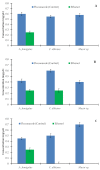Antibacterial and Antifungal Activity of the Extracts of Different Parts of Avicennia marina (Forssk.) Vierh
- PMID: 33525519
- PMCID: PMC7911470
- DOI: 10.3390/plants10020252
Antibacterial and Antifungal Activity of the Extracts of Different Parts of Avicennia marina (Forssk.) Vierh
Abstract
Increased problems associated with side effects and bacterial resistance of chemical drugs has prompted the research focus on herbal medicines in the past few decades. In the present investigation, the antimicrobial activity of the various parts of Avicennia marina (AM), a mangrove plant, has been evaluated. The plants were collected from the Jazan area of the Kingdom of Saudi Arabia. Primary extracts of roots, stem, leaves, fruits, and seeds were made in ethanol and fractioned in ethanol, ethyl acetate, petroleum ether, chloroform, and water. Minimal inhibitory concentration (MIC) and minimal bactericidal concentration (MBC) of the extracts were determined against Bacillussubtilis, Escherichia coli, Pseudomonas aeruginosa, and Staphylococcus aureus. It has been observed that the chloroform extract of roots of the AM exhibited inhibitory effects against both S. aureus (MIC = 1.5 ± 0.03 mg/mL) and E. coli (MIC = 1.7 ± 0.01 mg/mL). The ethanolic extract of the AM roots has shown antibacterial activity against Pseudomonas aeruginosa (MIC = 10.8 ± 0.78 mg/mL), Bacillussubtilis (MIC = 6.1 ± 0.27 mg/mL), Staphylococcus aureus (MIC = 2.3 ± 0.08 mg/mL), and Escherichia coli (MIC = 6.3 ± 0.28 mg/mL). The leaf extract of the AM in ethyl acetate showed antibacterial activity against S. aureus and E. coli. Antifungal activity of these extracts was also investigated against Aspergillus fumigatus and Candida albicans. Ethanolic extract of roots and seeds of the AM has shown antifungal activity against Aspergillus fumigatus when applied individually. Ethanolic extract of the AM fruits has shown an inhibitory effect on the growth of Aspergillus fumigatus and Candida albicans. It is suggested that the plant extracts of AM have tremendous antimicrobial activity against a group of microbes, and this effect depends on both the plant part and the solvent used for extraction. Therefore, this plant can be considered to treat various diseases caused by antibiotic-resistant bacteria.
Keywords: Avicennia marina; Bacillus subtilis; Escherichia coli; Pseudomonas aeruginosa; Staphylococcus aureus; antibacterial; antifungal.
Conflict of interest statement
The authors declare no conflict of interest.
Figures







Similar articles
-
Comparative study among Avicennia marina, Phragmites australis, and Moringa oleifera based ethanolic-extracts for their antimicrobial, antioxidant, and cytotoxic activities.Saudi J Biol Sci. 2022 Jan;29(1):111-122. doi: 10.1016/j.sjbs.2021.08.062. Epub 2021 Aug 25. Saudi J Biol Sci. 2022. PMID: 36105270 Free PMC article.
-
In vitro antifungal and antibacterial potentials of organic extracts of Avicennia marina collected from Rabigh Lagoon, Red Sea Coasts in Saudi Arabia.Braz J Biol. 2022 Oct 17;82:e265038. doi: 10.1590/1519-6984.265038. eCollection 2022. Braz J Biol. 2022. PMID: 36259892
-
Antibacterial effect of Asphodelus fistulosus aqueous and ethanolic crude extracts on gram positive and gram negative bacteria.Braz J Biol. 2022 Jul 15;84:e260029. doi: 10.1590/1519-6984.260029. eCollection 2022. Braz J Biol. 2022. PMID: 35857941
-
In vitro antibacterial and antifungal activities of extracts and fractions of leaves of Ricinus communis Linn against selected pathogens.Vet Med Sci. 2022 Jul;8(4):1802-1815. doi: 10.1002/vms3.772. Epub 2022 Feb 19. Vet Med Sci. 2022. PMID: 35182460 Free PMC article.
-
Antibacterial and antifungal activities and phytochemical profile of leaf extract from different extractants of Ricinus communis against selected pathogens.BMC Res Notes. 2017 Dec 1;10(1):660. doi: 10.1186/s13104-017-3001-2. BMC Res Notes. 2017. PMID: 29191226 Free PMC article.
Cited by
-
Phytochemical Composition and Antibacterial Activity of Barleria albostellata C.B. Clarke Leaf and Stem Extracts.Plants (Basel). 2023 Jun 21;12(13):2396. doi: 10.3390/plants12132396. Plants (Basel). 2023. PMID: 37446958 Free PMC article.
-
Antimicrobial Properties of Plant Fibers.Molecules. 2022 Nov 18;27(22):7999. doi: 10.3390/molecules27227999. Molecules. 2022. PMID: 36432099 Free PMC article. Review.
-
Comparative study among Avicennia marina, Phragmites australis, and Moringa oleifera based ethanolic-extracts for their antimicrobial, antioxidant, and cytotoxic activities.Saudi J Biol Sci. 2022 Jan;29(1):111-122. doi: 10.1016/j.sjbs.2021.08.062. Epub 2021 Aug 25. Saudi J Biol Sci. 2022. PMID: 36105270 Free PMC article.
-
Antimicrobial and Synergistic Effects of Syzygium cumini, Moringa oleifera, and Tinospora cordifolia Against Different Candida Infections.Cureus. 2024 Jan 24;16(1):e52857. doi: 10.7759/cureus.52857. eCollection 2024 Jan. Cureus. 2024. PMID: 38274587 Free PMC article.
-
Anti-Periodontopathogenic Ability of Mangrove Leaves (Aegiceras corniculatum) Ethanol Extract: In silico and in vitro study.Eur J Dent. 2023 Feb;17(1):46-56. doi: 10.1055/s-0041-1741374. Epub 2022 Apr 22. Eur J Dent. 2023. PMID: 35453169 Free PMC article.
References
-
- Nascimento G.G.F., Locatelli J., Freitas P.C., Silva G.L. Antibacterial activity of plant extracts and phytochemicals on antibiotic-resistant bacteria. Braz. J. Microbiol. 2000;31:247–256.
-
- Favre-Godal Q., Dorsaz S., Queiroz E.F., Marcourt L., Ebrahimi S.N., Allard P.M., Sanglard D. Anti-Candida Cassane-Type Diterpenoids from the Root Bark of Swartzia simplex. J. Nat. Prod. 2015;78:2994–3004. - PubMed
-
- Soberón J.R., Lizarraga E.F., Sgariglia M.A., Juárez M.B.C., Sampietro D.A., Altabef A.B., Vattuone M.A. Antifungal activity of 4-hydroxy-3-(3-methyl-2-butenyl) acetophenone against Candida albicans: Evidence for the antifungal mode of action. Antonie van Leeuwenhoek. 2015;108:1047–1057. - PubMed
-
- Siro I., Kapolna E., Kápolna B., Lugasi A. Functional food product development, marketing and consumer acceptance—A review. Appetite. 2008;51:456–467. - PubMed
-
- Turner M. Ecology: Mangrove maintenance. Nature. 2015;526:515. - PubMed
LinkOut - more resources
Full Text Sources
Other Literature Sources
Miscellaneous

